As your friend, I’m going to cut right to the chase and tell you the most important thing you need to know about Yin yoga…
YOU NEED IT!
And this article will give you the why and the how!
Phew. I’m glad we got that out of the way, aren’t you?
Whether you’re a new yogi or a seasoned practitioner, it’s likely you’ve been mystified by the term “Yin” yoga, and I totally get why!
It can look a lot of different ways depending on your Yin yoga teacher as it’s one of the less defined types of yoga.
So let’s explore what it is, why you need it, and how to do it so you can be on your mat and loving Yin in no time!
What is Yin Yoga?
At its broadest essence “Yin” yoga can include anything that is the opposite of “Yang” yoga. Just like the Taoist Yin-Yang symbol, “Yin” is equally important as “Yang” and makes something whole and balanced.
Kung Fu master, Paulie Zink, developed this style from Hatha yoga and Taoist yoga influences in the 1970s (if your yoga instructor talks about energy channels or meridians, internal organs, and Chi, it is coming from the Taoist influence).
“Yang” yoga is your sweaty morning power class, Ashtanga or Bikram class, or vinyasa flow that builds up to a complex peak pose. Yang qualities are masculine, solar, hot, upward, outward, mobile, active, and cultivate change and discipline while targeting your muscles.
That means “Yin” includes poses where you move less and spend more time relaxing into yoga postures. It has the opposite qualities of being feminine, lunar, cooling, downward, inward, still, and passive. Physically it targets connective tissues and mentally it is meditative and draws our attention inward to cultivate acceptance and surrender.
Who Should Do Yin Yoga?
Everybody!
Since most of us live “Yang” lives and are constantly active and on the go, we could all benefit from “Yin” to balance us. It can also be more accessible for those with physical or health conditions that don’t allow for a “Yang” style practice. But since Yin can improve flexibility, those who are already quite flexible might want to practice less frequently to maintain stability in their bodies.
What Are The Benefits of Yin Yoga?
Physically, Yin helps lengthen our connective tissues which can improve our flexibility, while it also strengthens and calms the nervous system.
Mentally, Yin can help focus the mind and develop mental resolve as we practice staying and relaxing near the edge of our comfort zone.
Energetically, Yin yoga helps remove energy blockages along the meridians to improve the flow of Chi (also called Qi or Prana) and balance the five elements in the body so that our body-minds can restore wellness. These energetic benefits of Yin yoga are based in its Taoist influence which includes Traditional Chinese Medicine.
Generally, the stillness and quiet of Yin helps balance our bodies, minds, and nervous systems from the Yang of our daily lives and physical activities. This helps prevent our bodies from needing to create this balance on their own by shutting down, becoming ill, getting injured, burning out, blowing up, etc.
Sounds great, right? Let’s give it a try, shall we!
Getting Started
Gather your yoga props! You’ll want at least a couple of the following: a block, bolster, blanket, and pillow.
Enter each pose slowly, and for poses with more stretching enter mindfully until you reach a mild stretching sensation, never to a point of pain.
To exit each pose, transition gently allowing 15-30 seconds to move into a “rebound” pose for one minute in between each posture. Your “rebound” pose is something comfortable where you are still for about one minute allowing connective tissues to reform and rehydrate.

10 Yin Yoga Poses to Melt Away Stress
Check out this Yin yoga sequence to help you unwind, open the hips, and mobilize the spine.
1. Supported Child’s Pose (Salamba Balasana)
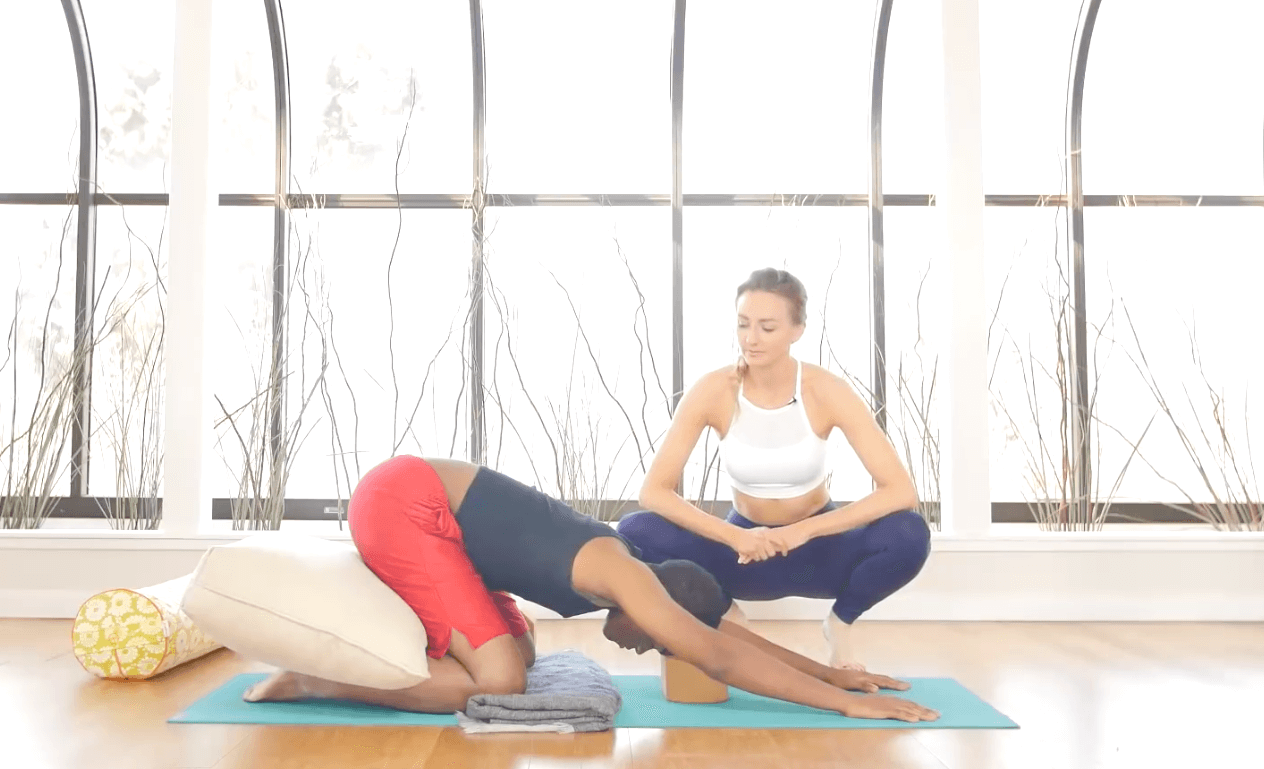
What it does: Releases the hips, back, and neck.
Chakras and meridians affected: Root chakra, Sacral chakra, Third eye chakra, Stomach/Spleen meridian
How to do it: Place a folded cushion under your shins and sit your hips onto your heels. Rest your arms along your sides and release your forehead onto a block, folded blanket, or pillow. Extra yummy bonus options are to place another blanket or pillow under your ankles, between your heels and your hips, or between your knees to support your torso. Enjoy for 3-5 minutes.
2. Low Lunge Pose (Anjaneyasana)
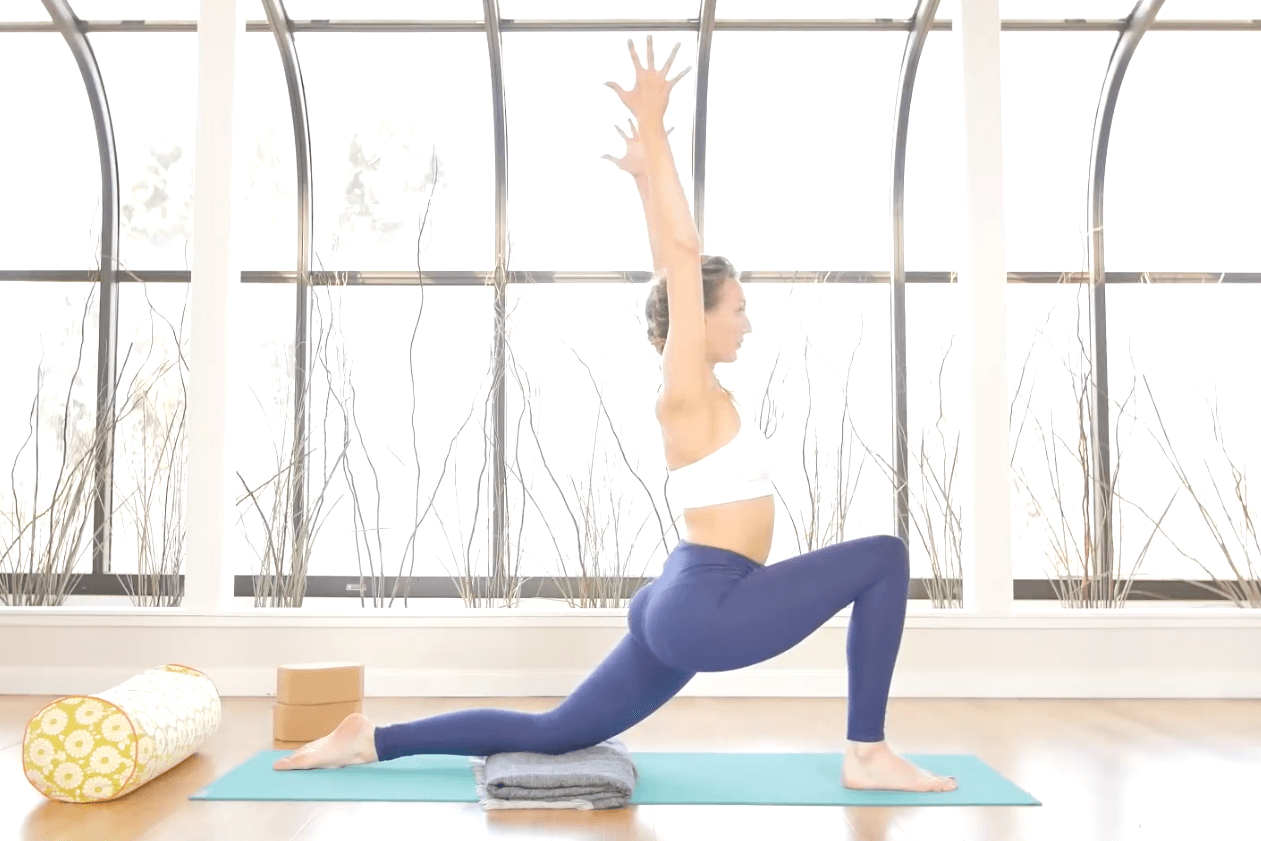
What it does: Stretches the hip flexors to balance lots of daily sitting and release tension in the lower back.
Chakras and meridians affected: Sacral chakra, Kidney/urinary bladder meridian
How to do it: To get into low lunge, first begin in tabletop position. Cushion your knees with a blanket and bring the right foot forward in between the hands with the knee on top of the ankle. Slide your left knee back slightly and let your hips sink and glide forward until you feel a mild stretch in the front of the right hip. You can place your hands on blocks for more support. Find stillness here for one minute on each side.
3. Broken Wing Pose
What it does: Opens the front of the chest, shoulder, and biceps to help improve hunched posture.
Chakras and meridians affected: Heart chakra, Heart/small intestines meridian
How to do it: Lie on your stomach and extend your right arm straight out to a 90 degree angle. Place your left hand on the ground near your left shoulder and roll onto your right side until you feel a stretching sensation in the right side of your chest. You can stack your left leg on your right or bend the top knee and place the left foot flat for more sensation. Breathe here for 3-4 minutes on each side.
4. Butterfly Pose (Baddha Konasana)
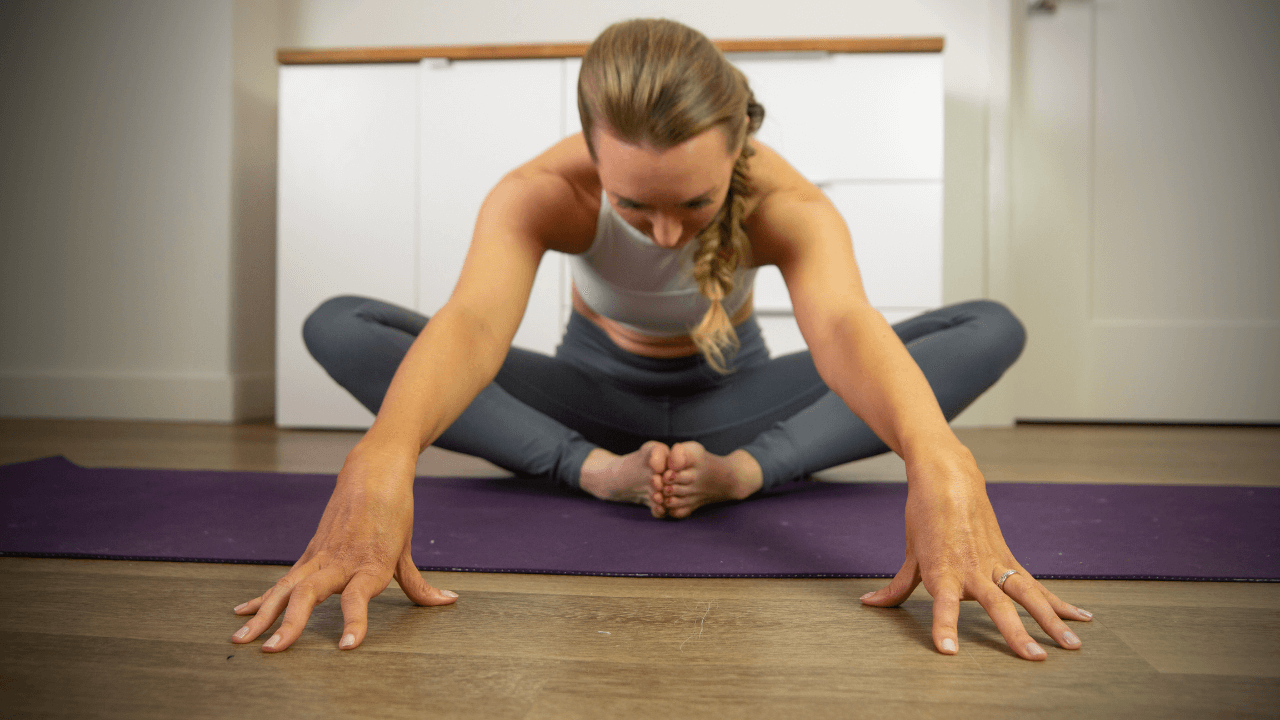
What it does: Lengthens the tissues of the inner thighs, lower back, hamstrings, and hip flexors.
Chakras and meridians affected: Root chakra, Sacral chakra, Kidney/urinary bladder meridian, Liver/gall bladder meridian
How to do it: From seated, bring the soles of the feet together a comfortable distance away from the body. Tilt the top of the pelvis forward as you fold over your legs, supporting your head with something soft. If the lower back is rounding, place a folded blanket or bolster underneath your hips. Settle into the pose for 3-5 minutes.

Learn how to do 11 of the most popular yoga poses correctly. Free video + PDF download.

5. Pigeon Pose (Eka Pada Rajakapotasana)
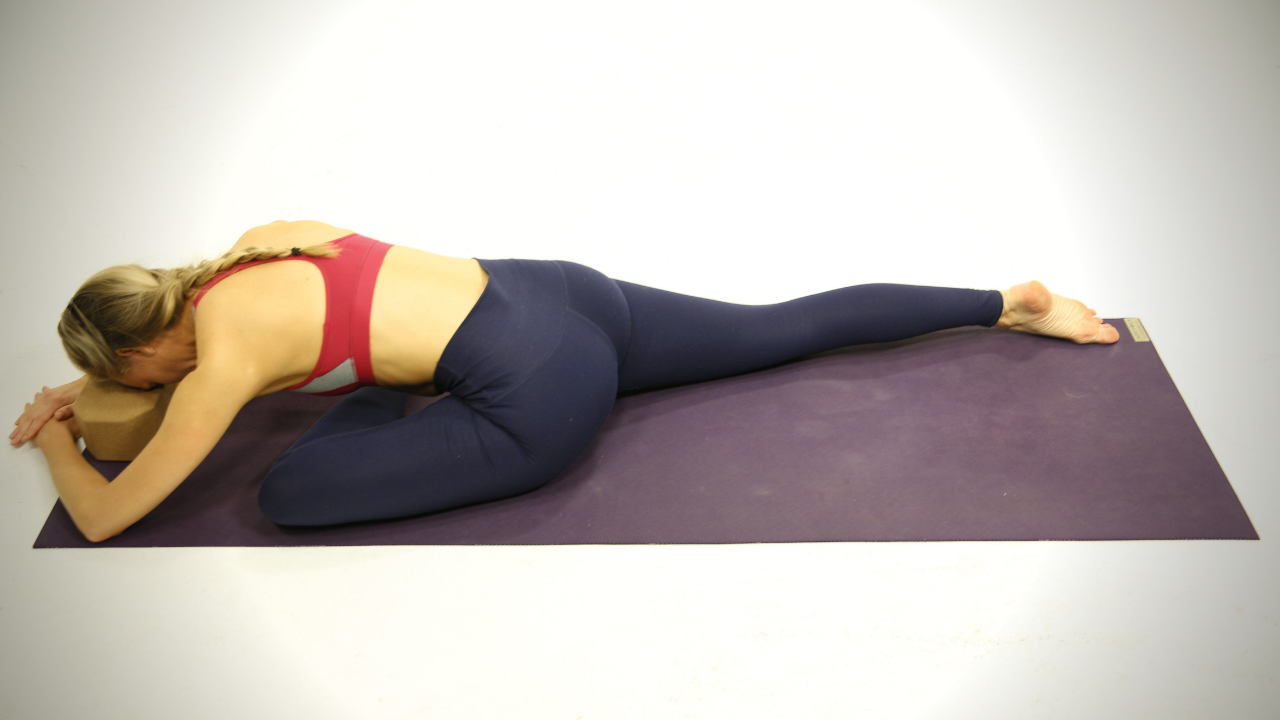
What it does: Softens the outer hips and hip flexors.
Chakras and meridians affected: Sacral chakra, Solar plexus chakra, Kidney/urinary bladder meridian, Liver/gall bladder meridian, Stomach/spleen meridian
How to do it: From tabletop, bring your right knee behind your right wrist and point your right toes towards your left hip creating a 45 degree angle with your shin. Slide your left leg back and lower your hips onto the ground or a folded blanket or bolster if they don’t connect with the floor. Lengthen the spine forward and fold over your bent right leg, supporting your head as desired. Soften here for 3-5 minutes on each side.
You might also like: 10 Yoga Poses For Hip Pain That Anyone Can Do
6. Seated Forward Bend (Paschimottanasana)
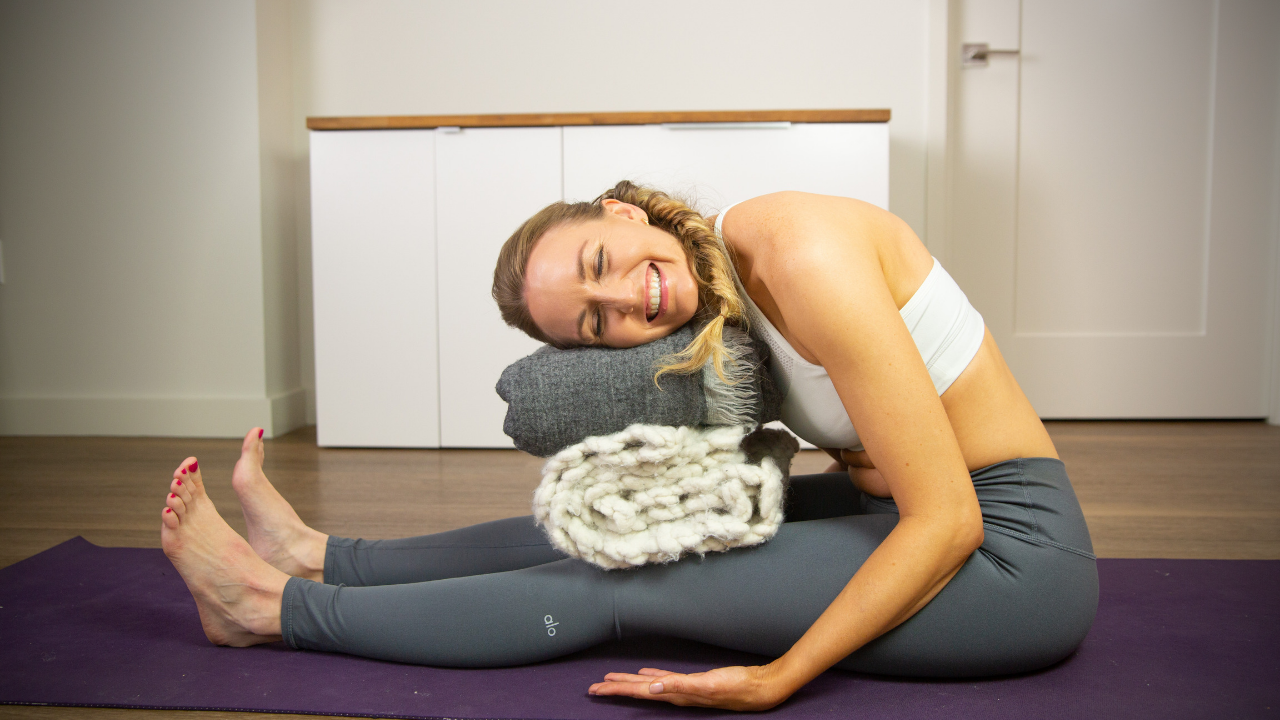
What it does: Lengthens the entire back line of the body, relieves tight hamstrings, and relaxes the nervous system.
Chakras and meridian affected: Root chakra, Sacral chakra, Heart chakra, Kidney/urinary bladder meridian
How to do it: Sit upright and extend your legs straight out in front of you. If your lower back is rounding, sit on a bolster or folded blanket. Tilt the top of the pelvis forward then fold forward letting your forearms resting alongside your legs. Support your head with a pillow or bolster placed on top of your legs. Support behind the knees with a pillow if you feel too much sensation in the backs of the knees or hamstrings. Relax here for 4-5 minutes.
7. Supported Fish Pose (Matsyasana)
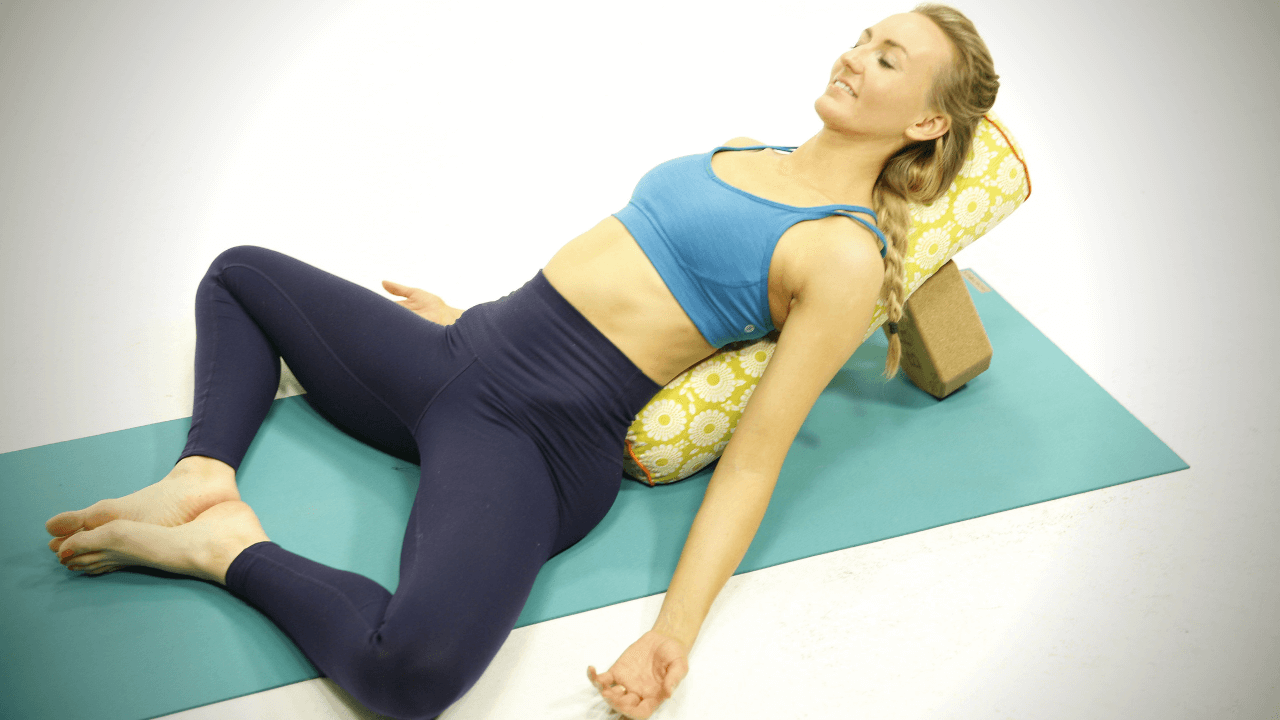
What it does: Gently opens the front lines of the chest, shoulders, and neck.
Chakras and meridians affected: Solar plexus chakra, Heart chakra, Throat chakra, Heart/small intestines meridian, Lungs/large intestines meridian
How to do it: Place a bolster, pillow, or block onto your mat and lie on your back with this support beneath your shoulder blades. Then move yourself a couple inches towards the top of your mat until the upper part of the shoulders touch the ground and you feel a gentle opening across the center of the chest. Find any position that feels good with your arms and legs and if it feels better for the neck, support your head with a prop at whatever height feels good. Release here for 4-5 minutes.
8. Banana Pose (Bananasana)
What it does: Releases compression along the sides of the ribcage to make more space for breath while lengthening the tissues along the sides of the waist, chest, and hips.
Chakras and meridians affected: Solar plexus chakra, Heart chakra, Heart/small intestines meridian, Lungs/Large intestines meridian
How to do it: Take your hips to the left side of your mat and take your feet and the crown of your head towards the right side of your mat to create a banana shape with your body. Ground evenly through both shoulders and both hips. Feel welcome to stretch your arms overhead and encircle the left wrist with the right fingers and cross the left ankle on top of the right. Rest here for 3-4 minutes on each side.
9. Reclining Eagle Spinal Twist Pose (Supta Parivrtta Garudasana)
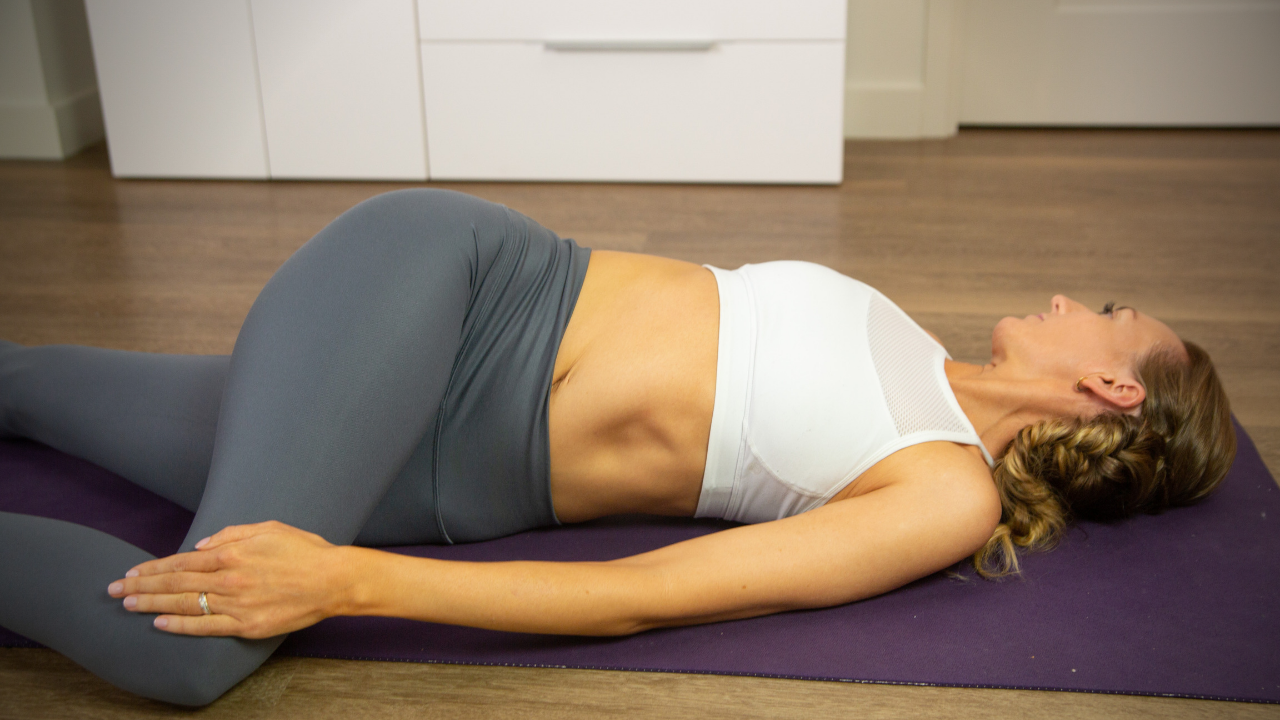
What it does: Helps realign the vertebra, opens the chest, neck, and outer hips.
Chakras and meridians affected: Solar plexus chakra, Heart chakra, Heart/small intestines meridian, Lungs/large intestines meridian
How to do it: Lie on your back with your knees bent and feet flat on the floor. Shift your hips two inches to the right then cross your right knee over your left and slowly release both knees to the left side of your mat. Make a “T”-shape with your arms and turn your head to the right. You can stack the knees if crossing them creates too much sensation in your hips or lower back. Lounge here for 4-5 minutes on each side.
10. Supported Savasana
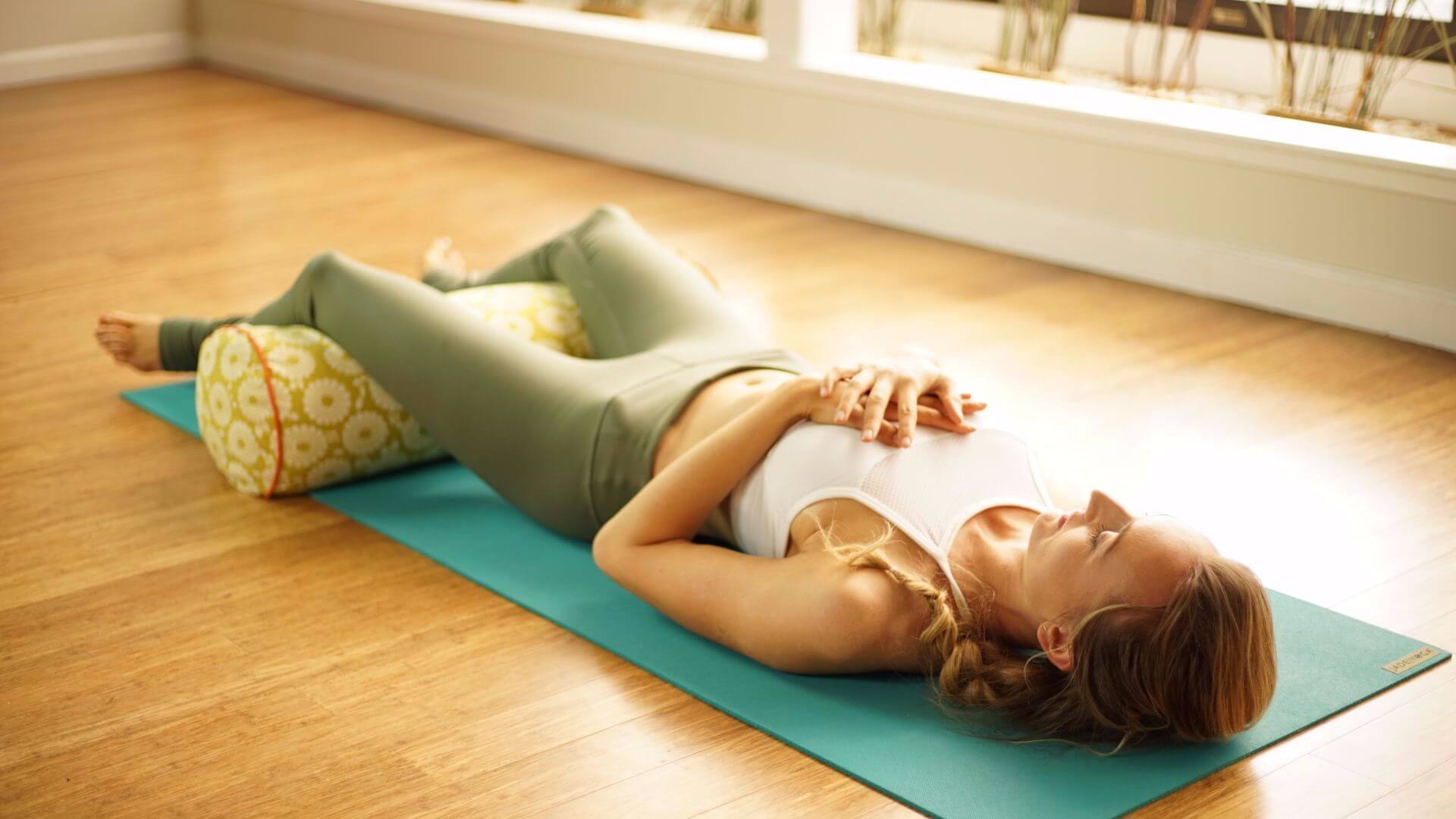
What it does: Helps relax the body and mind.
Chakras and meridians affected: Third eye chakra, Crown chakra
How to do it: Lie on your back and place a bolster or pillow underneath your knees. You can put your hands on your chest or make a starfish shape with your body, taking your arms wide overhead and legs as wide as comfortable. Let go of all muscular activity, effort, and doing and simply be for 5-10 minutes.
Want to see more yoga postures? See more in my Yoga Pose Directory.
How’d it go? I hope you enjoyed trying this different type of yoga!
But if not, remember that there is a style of yoga for everybody! So if the classes you’re trying aren’t inspiring you, keep exploring.
There are many different and beneficial forms of yoga that you just might love! Like Bhakti yoga (chanting), Yoga nidra (yogic sleep), and Mantra yoga to name a few.
Ask your favorite yoga instructor what else they recommend for you or immerse yourself in a yoga teacher training to discover how to use the different styles of yoga to best serve you!
Happy practicing!
Next Steps
- Check out my YouTube channel and find some yoga classes that you can try out for yourself!
- Download my Yoga Calendars for an at-home practice, guided by me on YouTube!
- Join Uplifted for exclusive content that you can access right from the app. Take a deep dive into your practice with me this year!
Experience 3 Training Videos from Inside My 200-Hour Online YTT

YOU MIGHT ALSO LIKE
- What Is Somatic Yoga? Everything You Need To Know
- What is Kriya Yoga? The Philosophy and Practice
- Try This 30-Minute Yoga Nidra Script for Deep Sleep and Relaxation [+ Video]
- 9 Fierce Kundalini Yoga Poses to Light Your Inner Fire
- Tantra Yoga: The Most Misunderstood Path of Yoga
- Styles and Types of Yoga: The Complete Beginner’s Handbook
- What is Hatha Yoga? The Origins, Definition, Poses, & Practice
- What Is Trauma Informed Yoga And Should I Get Certified?
- How To Do High Lunge Pose
- 10 Yin Yoga Poses To Melt Away Stress (For Beginners)
- Amazing Benefits of Ashtanga Yoga That Your Studio Won’t Teach You
- Earthing Yoga 101: 6 Poses To Connect With The Earth (Root Chakra)
- Find A Gentle Yoga Sequence That Anyone Can Do
Learn how to do 11 of the most popular yoga poses correctly. Free video + PDF download.










